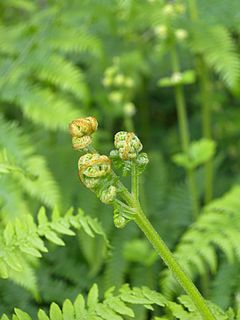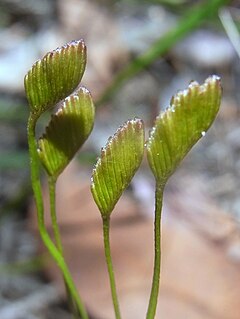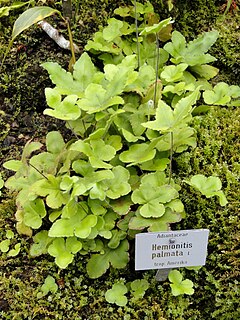
Lycopodiopsida is a class of vascular plants known as lycopods, lycophytes or other terms including the component lyco-. Members of the class are also called clubmosses, firmosses, spikemosses and quillworts. They have dichotomously branching stems bearing simple leaves called microphylls and reproduce by means of spores borne in sporangia on the sides of the stems at the bases of the leaves. Although living species are small, during the Carboniferous, extinct tree-like forms formed huge forests that dominated the landscape and contributed to coal deposits.

Thelypteridaceae is a family of about 900 species of ferns in the order Polypodiales. In the Pteridophyte Phylogeny Group classification of 2016, it is placed in the suborder Aspleniineae. Alternatively, the family may be submerged in a very broadly defined family Aspleniaceae as the subfamily Thelypteridoideae.

Osmunda is a genus of primarily temperate-zone ferns of family Osmundaceae. Five to ten species have been listed for this genus.

Marattiaceae is the only family of extant (living) ferns in the order Marattiales. In the Pteridophyte Phylogeny Group classification of 2016, Marattiales is the only order in the subclass Marattiidae. The family has six genera and about 110 species. Many are different in appearance from other ferns, having large fronds and fleshy rootstocks.

A pteridophyte is a vascular plant that disperses spores. Because pteridophytes produce neither flowers nor seeds, they are sometimes referred to as "cryptogams", meaning that their means of reproduction is hidden. Ferns, horsetails, and lycophytes are all pteridophytes. However, they do not form a monophyletic group because ferns are more closely related to seed plants than to lycophytes. "Pteridophyta" is thus no longer a widely accepted taxon, but the term pteridophyte remains in common parlance, as do pteridology and pteridologist as a science and its practitioner, respectively. Ferns and lycophytes share a life cycle and are often collectively treated or studied, for example by the International Association of Pteridologists and the Pteridophyte Phylogeny Group.

The Cyatheaceae are a family of ferns, the scaly tree ferns, one of eight families in the order Cyatheales in the Pteridophyte Phylogeny Group classification of 2016. Alternatively, the family may defined much more broadly as the only family in the Cyatheales, with the PPG I family treated as the subfamily Cyatheoideae. The narrower circumscription is used in this article.

The Athyriaceae are a family of terrestrial ferns in the order Polypodiales. In the Pteridophyte Phylogeny Group classification of 2016 (PPG I), the family is placed in the suborder Aspleniineae, and includes two genera. Alternatively, it may be treated as the subfamily Athyrioideae of a very broadly defined family Aspleniaceae. The family has with a cosmopolitan distribution.

Woodwardia is a genus of ferns in the family Blechnaceae, in the suborder Aspleniineae of the order Polypodiales. Species are known as chain ferns. The genus is native to warm temperate and subtropical regions of the Northern Hemisphere. They are large ferns, with fronds growing to 50–300 cm long depending on the species. The fossil record of the genus extends to the Paleocene.

The Polypodiidae, commonly called leptosporangiate ferns, formerly Leptosporangiatae, are one of four subclasses of ferns, and the largest of these, being the largest group of living ferns, including some 11,000 species worldwide. The group has also been treated as the class Pteridopsida or Polypodiopsida, although other classifications assign them a different rank. Older names for the group include Filicidae and Filicales, although at least the "water ferns" were then treated separately.

The Lomariopsidaceae is a family of ferns with a largely tropical distribution. In the Pteridophyte Phylogeny Group classification of 2016 (PPG I), the family is placed in the suborder Polypodiineae of the order Polypodiales. Alternatively, it may be treated as the subfamily Lomariopsidoideae of a very broadly defined family Polypodiaceae sensu lato.

Lindsaeaceae is a pantropical family of ferns in the order Polypodiales. It contains six or seven genera with about 220 known species, some of which also extend into the more temperate regions of eastern Asia, New Zealand, and South America.

Schizaeaceae is a family of ferns in the order Schizaeales. In the Pteridophyte Phylogeny Group classification of 2016, it includes only two genera. Alternatively, two families kept separate in PPG I, Lygodiaceae and Anemiaceae, may be included in Schizaeaceae so that the family has four genera. In this approach, the Schizaeaceae of PPG I is treated as the subfamily Schizaeoideae.

Hypodematiaceae is a family of ferns in the order Polypodiales. In the Pteridophyte Phylogeny Group classification of 2016 (PPG I), the family is placed in the suborder Polypodiineae. Alternatively, it may be treated as the subfamily Hypodematioideae of a very broadly defined family Polypodiaceae sensu lato. The family consists of two, or in some versions three, small genera.

Tectariaceae is a family of leptosporangiate ferns in the order Polypodiales. In the Pteridophyte Phylogeny Group classification of 2016 (PPG I), the family is placed in the suborder Polypodiineae. Alternatively, it may be treated as the subfamily Tectarioideae of a very broadly defined family Polypodiaceae sensu lato. The family comprises seven genera, of which Tectaria is by far the largest.

Microsoroideae is a subfamily in the fern family Polypodiaceae in the Pteridophyte Phylogeny Group classification of 2016 (PPG I). The subfamily is also treated as the tribe Microsoreae within a very broadly defined family Polypodiaceae sensu lato. In either treatment, it includes the previously separated tribe Lepisoreae.
Drynarioideae is a subfamily of the fern family Polypodiaceae in the Pteridophyte Phylogeny Group classification of 2016 (PPG I). The subfamily is also treated as the tribe Drynarieae within a very broadly defined family Polypodiaceae sensu lato. In either case, it includes the previously separated tribe Selligueeae.

Callistopteris is a fern genus in the family Hymenophyllaceae. The genus is accepted in the Pteridophyte Phylogeny Group classification of 2016 but not by some other sources, which sink it into a broadly defined Trichomanes.

Lycopodioideae is a subfamily in the family Lycopodiaceae in the Pteridophyte Phylogeny Group classification of 2016. It is equivalent to a broad circumscription of the genus Lycopodium in other classifications. Like all lycophytes, members of the Lycopodioideae reproduce by spores. The oldest fossils of modern members of the family date to the Early Cretaceous.

Hemionitis is a genus of ferns in the subfamily Cheilanthoideae of the family Pteridaceae. Its circumscription varies greatly in different systems of fern classification. In the Pteridophyte Phylogeny Group classification of 2016, it was one of more than 20 genera in the subfamily Cheilanthoideae, and was said to have five species. Other sources treat it as the only genus in the subfamily, and so accept about 450 species. With the restricted circumscription, species are native to tropical America.
Tricholepidium is a genus of ferns in the family Polypodiaceae, subfamily Microsoroideae, according to the Pteridophyte Phylogeny Group classification of 2016 (PPG I).


















